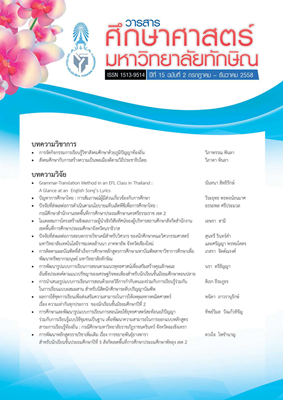การพัฒนารูปแบบการเรียนการสอนตามแนวพุทธศาสน์เพื่อเสริมสร้าง คุณลักษณะอันพึงประสงค์ตามแนวปรัชญาของเศรษฐกิจพอเพียง สำหรับนักเรียนชั้นมัธยมศึกษาตอนปลาย
Main Article Content
บทคัดย่อ
บทคัดย่อ
การวิจัยครั้งนี้มีวัตถุประสงค์ดังนี้ 1) เพื่อพัฒนารูปแบบการเรียนการสอนตามแนวพุทธศาสน์เพื่อเสริมสร้างคุณลักษณะอันพึงประสงค์ตามแนวปรัชญาของเศรษฐกิจพอเพียงสำหรับนักเรียนชั้นมัธยมศึกษาตอนปลาย 2) เพื่อประเมินประสิทธิผลของรูปแบบการเรียนการสอนตามแนวพุทธศาสน์เพื่อเสริมสร้างคุณลักษณะอันพึงประสงค์ตามแนวปรัชญาของเศรษฐกิจพอเพียงสำหรับนักเรียนชั้นมัธยมศึกษาตอนปลาย และ 3) เพื่อขยายผลการนำรูปแบบการเรียนการสอนตามแนวพุทธศาสน์เพื่อเสริมสร้างคุณลักษณะอันพึงประสงค์ตามแนวปรัชญาของเศรษฐกิจพอเพียงสำหรับนักเรียนชั้นมัธยมศึกษาตอนปลาย ไปใช้ในเนื้อหาสาระอื่นๆ ของกลุ่มสาระการเรียนรู้สังคมศึกษา ศาสนาและวัฒนธรรม กลุ่มตัวอย่างในการวิจัยครั้งนี้ เป็นนักเรียนชั้นมัธยมศึกษาปีที่ 4โรงเรียนแก้งคร้อวิทยา จำนวน 40 คน ที่เรียนรายวิชาสังคมศึกษาในภาคเรียนที่ 1 ปีการศึกษา 2557 เครื่องมือที่ใช้ในการวิจัย ประกอบด้วย แผนการจัดการเรียนรู้ แบบทดสอบวัดผลสัมฤทธิ์ทางการเรียน แบบประเมินคุณลักษณะอันพึงประสงค์ การวิเคราะห์ข้อมูลโดยใช้ค่าเฉลี่ย () ค่าเบี่ยงเบนมาตรฐาน (S.D.) ค่าทีแบบไม่อิสระ(t-test dependent) และการวิเคราะห์เนื้อหา (content analysis)
ผลการวิจัย พบว่า
1. รูปแบบการเรียนการสอนตามแนวพุทธศาสน์เพื่อเสริมสร้างคุณลักษณะอันพึงประสงค์ตามแนวปรัชญาของเศรษฐกิจพอเพียงสำหรับนักเรียนชั้นมัธยมศึกษาตอนปลาย มีองค์ประกอบคือ หลักการ วัตถุประสงค์ กระบวนการเรียนการสอน การวัดและประเมินผล และปัจจัยที่เอื้อต่อการเรียนรู้ ประกอบด้วยระบบสังคม หลักการตอบสนอง และระบบสนับสนุนโดยรูปแบบการเรียนการสอนที่พัฒนาขึ้นมีกระบวนการเรียนการสอน 5 ขั้นตอน คือ 1) ขั้นสร้างศรัทธาและเสนอข้อเท็จจริง (ปรโตโฆสะ) 2) ขั้นสะท้อนคิด (โยนิโสมนสิการ) 3) ขั้นค้นพบหลักการ (สัมมาทิฎฐิ) 4) ขั้นสู่กระบวนการเรียนรู้ (ไตรสิกขา) และ 5) ขั้นประเมินผล และประยุกต์ใช้ (ภาวนา 4)
2. ประสิทธิผลของรูปแบบ พบว่า 2.1) หลังเรียนตามรูปแบบนักเรียนมีผลสัมฤทธิ์ทางการเรียนสูงกว่าก่อนเรียนอย่างมีนัยสำคัญทางสถิติที่ระดับ .01 2.2) นักเรียนมีพัฒนาการด้านคุณลักษณะอันพึงประสงค์สูงขึ้นจากระดับการตอบสนองเป็นระดับการจัดระบบ
3. ผลการขยายผลรูปแบบ พบว่า หลังเรียนตามรูปแบบนักเรียนมีผลสัมฤทธิ์ทางการเรียนหลังเรียนสูงกว่าก่อนเรียนอย่างมีนัยสำคัญทางสถิติที่ระดับ .01 และมีพัฒนาการด้านคุณลักษณะอันพึงประสงค์สูงขึ้นจากระดับการตอบสนอง เป็นระดับการเห็นคุณค่า
Abstract
The purposes of this research were: 1) to develop the instructional model based on Buddhism to enhance the desired characteristics focusing on sufficiency economy philosophy for high school students, 2) to evaluate the effectiveness of the instructional model based on Buddhism to enhance the desired characteristics focusing on sufficiency economy philosophy for high school students and 3) to disseminate the instructional model based on Buddhism ot enhance the desired characteristics focusing on sufficiency economy philosophy for high school students in other subjects of Social Studies,Religion and Culture .
The sample consisted of 40 students who studied at Kaengkhrowittaya School for the first semester in 2014. The research instruments were: 1) lesson plans 2) learning achievement test, and 3) the desired characteristics test. The data were analyzed by using mean (), standard deviation (S.D.), t-test for dependent sample and content analysis.
The results of this research were as follows:
1. The instructional development model based on Buddhism to enhance the desired characteristics focusing on sufficiency economy philosophy for high school students were: 1) the principle 2) the objective 3) the instructional process and 4) evaluation 5) the factors supporting learning consisted of 3 components, 1) social system 2) principle of reaction 3) supporting system and the learning process consisted of five steps: 1) faith forming and fact discovery (Paratoghosa) 2) reflection (Yonisomanasikara)3)principle construction (Sammaditthi) 4)learning process(Tri-sikkha) 5)evaluation and application.(Bhavana)
2. The effectiveness of the instructional development model revealed that the learning achievement from the post-test was significantly higher than the pre - test at the .01 t level and the desired characteristics were developed from the responding level to the organization level.
3. The results of dissemination revealed that the learning achievement from the post-test was significantly higher than the pre-test at the .01 level and the desired characteristics were developed from the responding level to the value level.
Article Details
ในกรณีที่กองบรรณาธิการ หรือผู้เชี่ยวชาญ ซึ่งได้รับเชิญให้เป็นผู้ตรวจบทความวิจัย หรือ บทความทางวิชาการมีความเห็นว่าควรแก้ไขความบกพร่อง ทางกองบรรณาธิการจะส่งต้นฉบับให้ ผู้เขียนพิจารณาจัดการแก้ไขให้เหมาะสมก่อนที่จะลงพิมพ์ ทั้งนี้ กองบรรณาธิการจะยึดถือความคิด เห็นของผู้เชี่ยวชาญเป็นเกณฑ์


